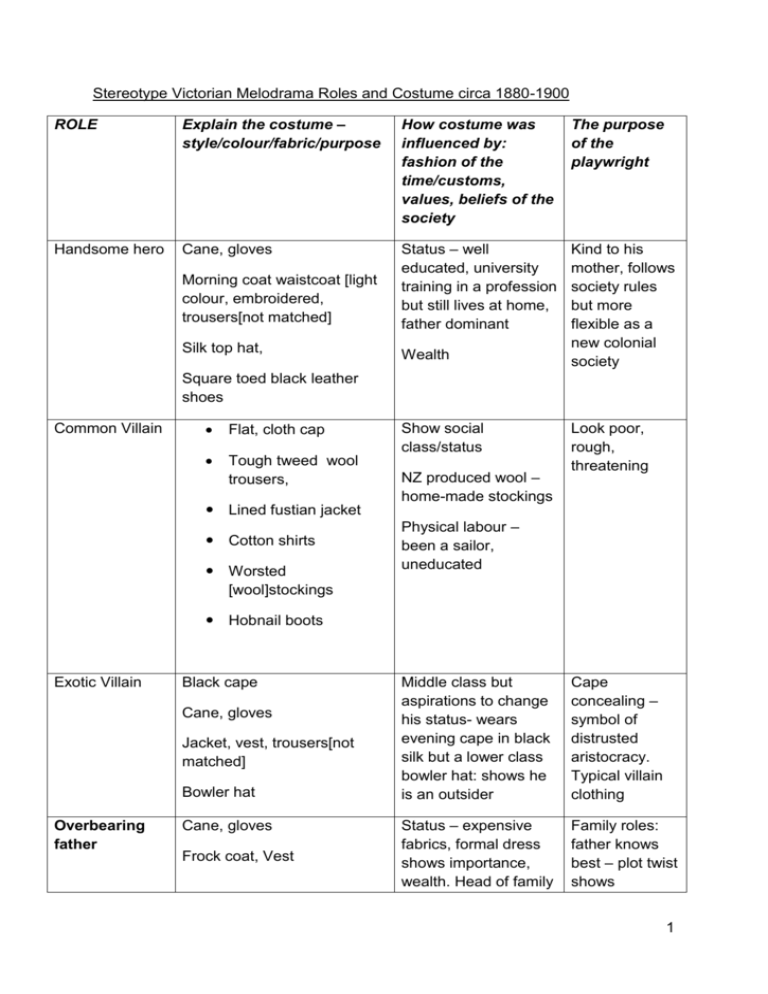Victoriancostume
advertisement

Stereotype Victorian Melodrama Roles and Costume circa 1880-1900
ROLE
Explain the costume –
style/colour/fabric/purpose
How costume was
influenced by:
fashion of the
time/customs,
values, beliefs of the
society
The purpose
of the
playwright
Handsome hero
Cane, gloves
Morning coat waistcoat [light
colour, embroidered,
trousers[not matched]
Status – well
educated, university
training in a profession
but still lives at home,
father dominant
Silk top hat,
Wealth
Kind to his
mother, follows
society rules
but more
flexible as a
new colonial
society
Square toed black leather
shoes
Common Villain
Flat, cloth cap
Tough tweed wool
trousers,
Lined fustian jacket
Cotton shirts
Worsted
[wool]stockings
Show social
class/status
NZ produced wool –
home-made stockings
Look poor,
rough,
threatening
Physical labour –
been a sailor,
uneducated
Hobnail boots
Exotic Villain
Black cape
Cane, gloves
Jacket, vest, trousers[not
matched]
Bowler hat
Overbearing
father
Cane, gloves
Frock coat, Vest
Middle class but
aspirations to change
his status- wears
evening cape in black
silk but a lower class
bowler hat: shows he
is an outsider
Cape
concealing –
symbol of
distrusted
aristocracy.
Typical villain
clothing
Status – expensive
fabrics, formal dress
shows importance,
wealth. Head of family
Family roles:
father knows
best – plot twist
shows
1
trousers[not matched]
Silk top hat
so could not be
frivolous or fashion
chasing
hypocrisy
Show how factory
machinery had made
elaborate clothing
[lace,frills, buttons,
bows] cheap and
accessible. Upwardly
mobile- how servants
could become
business owners
Comic effect
and also to
show her
vulgar
ambitions
Dirty jobs to do-keep
dress clean [few
clothes as washing
difficult]
Many servant
types from
maid of all work
to expensive
French maid.
High-collar shirt
Cravat [old-fashioned]
Black oxford lace-up shoe
Vulgar rich
Drawers=long under-pants
Lace morning cap or more
elaborate evening cap
Petticoats- calico & cambric
Outdoors- very frilly bonnet
Jewellery – pearls, matching
bracelets, brooches, rings
Voluminous shawl
Lace/ribbons
became
cheap/popular
when machine
made
Black – mourning
Chatelaine,Mourning brooch
Servants:{Poor
but honest}
Starched, white cotton aprons
and caps, wooden clogs and,
patched, cut-down darned
clothes darned
Ladies maid – couldsew, care
for clothes, better clothes but
modesty required – dark
colours & narrow skirts.
Music hall
actress
{Miss Yolanda }
Invalid mother
{Mrs F}
Must be
subservient –
curtsey, bow,
speak little
Bare shoulders in evening
dress
A performer – so
costume is risque,
provocative – shows
legs, ankles. Bright
colours
Show her as a
moral woman
despite her
occupation
Full skirts- many petticoats
and/or a crinoline; tight
corset;
Extreme modesty–
covering the body;
corsets make her frail
Fainting- tight
corset, physical
and social
Flounced skirts, corset
Printed muslin
2
Clothes cover her head to toe
Lace cap- married women
only
& fainting; shown the
confined and
controlled life of
upper-class woman
Gloves at all times to protect
skin [fair skin shows status]
Cover to maintain fair
skin
constraints
Black for older women
Fan
Heroine {Miss
Anne}
Cotton undergarments
Long heavy skirts
Well-brought up
Status and role
middle class girl, polite of women,
and decorous
Apron- embroidered or of rich
satin fabric [at home]
Parasol
bonnet
Respectable
spinster
{Miss Prim}
Gowns
Petticoats/shifts/
Chemise of cotton or flannel
Social role of womeneducation becoming
respectable job but
must dress modestly
and “know her place”
Handkerchiefs
Rational Dress
reform
Temperance
Society
Morality &
modesty
Neckerchiefs
Stays
Black worsted
stockings
Bonnet
Narrow skirt
The
entrepreneur
{Mr Harry
Fortuso}
“Oh the would be swell…with
their trousers cut so tight/ a
short flash coat in light tweed
Bowler hat “a black
bellhopper tile”
Men’s cliothing had its
fashions- bright
waistcoats, ties.
Opportunities in
trade/ colonys
to become
wealthy.
Young,
thrusting
3
Waistcoat-bright colour
elaborate, embroidered
entrepreneur
winged collar shirt and big
knotted tie or even a bow tie
Exotic hairstyle- moustache/
sideburns/fringe beard
A cane [really smart]
Vocabulary:
Crinoline- a cage shaped petticoat
stiffened with steel wireBodice –
dress top- tightfitting, waisted
Fichu- a small, modest shawl,
triangular, lace or net to cover a
low décolletage
Corsets- to achieve a fashionable
tiny waist tight corsets were worn;
made of whalebone or steel in
fabric casing, laced tight, made
breathing difficult
Voluminous shawls & coats
[pelisse] in silk/indian cotton. Goat
fleece[angora]
Chartalaine – attached to waistkeys, scissors, watches, thimbles
Men’s watch on chain, with extras,
eg: cigar cutter
Mourning jewellery – brooches with
the deceased’s hair/picture
Hairstyles: only unmarried girls
wore their hair loose, married
woman wore hair up
Stockings: White or pale Silk
stockings expensive/ cottonmiddle class/home-made knitted
wool stockings [working poor]
Bonnets/ Hats/ Caps- [for married
women] lawn, lace, embroidery;
morning caps worn all day;
evening caps- more decorated;
black ribbons for mourning {must
cover head in public]
Vest = waistcoat
Sleeves: many styles of sleeve:
pagoda, puff, gathered, plain,
cuffs, legofmutton
Bertha – a soft collar of lace or
transparent fabric worn over an
evening dress
Trim: fringes, braid, piping, bows
Pastel shades, dove gray, white for
young women/ Black for older
women/ mourning
In 1856 anailine dyes were
invented and colours became
bright.
Evening fabrics: silk, velvet,
brocade, taffeta
Day fabrics: cotton, muslin, linen,
gingham, wool/cotton mix
Parasols,Gloves,mittens,Hats
4








